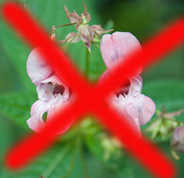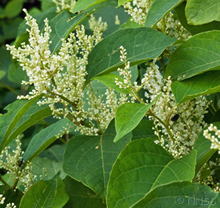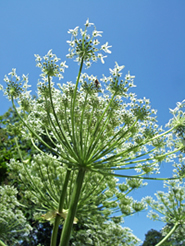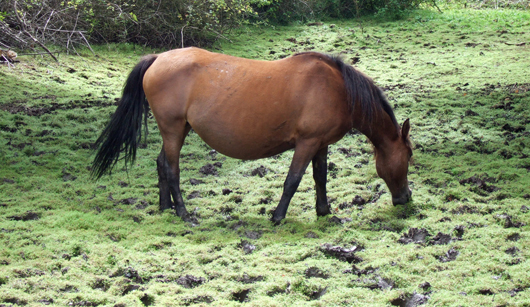UK: Keeping invaders out of the Forest
15.12.09
The New Forest is one of the most important areas for wildlife in Western Europe but its rivers and wetlands are threatened by an invasion of non-native plants. The battle lines are drawn and Catherine Chatters describes how she is taking up the fight.
 Japanese knotweed, giant hogweed, Himalayan balsam (pictured left), American skunk cabbage and New Zealand pygmyweed were introduced to the UK to be grown as ornamental garden plants or, in the case of New Zealand pygmyweed, as a oxygenator for garden ponds, but they have all jumped the garden fence and invaded the countryside.
Japanese knotweed, giant hogweed, Himalayan balsam (pictured left), American skunk cabbage and New Zealand pygmyweed were introduced to the UK to be grown as ornamental garden plants or, in the case of New Zealand pygmyweed, as a oxygenator for garden ponds, but they have all jumped the garden fence and invaded the countryside.
They grow vigorously, spread rapidly and can quickly elbow-out our native wildflowers which provide important food and nectar for invertebrates. Left un-checked these plants can cause problems for farmers, graziers, fishermen and all those who want to enjoy our countryside.

Japanese knotweed (left) and giant hogweed (below) are two of the most vigorous invasive species. Japanese knotweed is notoriously difficult to eradicate as it can re-grow from only a tiny amount of vegetative material.
Photos courtesy of GB Non-Native Species Secretariat
 Although responsibility for their control rests with the relevant landowners, the lack of a co-ordinated approach to dealing with them has been a major obstacle. In recognising this problem, conservation organisations have recently joined forces to create the New Forest Non-Native Plants Project.
Although responsibility for their control rests with the relevant landowners, the lack of a co-ordinated approach to dealing with them has been a major obstacle. In recognising this problem, conservation organisations have recently joined forces to create the New Forest Non-Native Plants Project.
This initiative is a joint partnership between the Hampshire and Isle of Wight Wildlife Trust, the Forestry Commission, Environment Agency, Natural England, Department for Environment, Food and Rural Affairs (Defra) and the New Forest National Park Authority who are contributing through core funding and the Sustainable Development Fund.
The Project was officially launched on 22 May 2009 to coincide with International Day for Biological Diversity which, this year, highlighted the problems caused by invasive species. We formed a plan and over the next three years we will identify where these plants are a problem (particularly river valleys), arrange for control work, commission research in control methodology, and raise awareness of the harm these plants can cause our unique flora.
To bring the plan to life I started as the New Forest Non-Native Plants Project Officer for the Hampshire & Isle of Wight Wildlife Trust in May 2009 and have been busy collating records of invasive plants in the New Forest area ever since. It’s especially important to identify landowners who have these plants on their land and it’s been really encouraging to hear the positive responses from those who recognise the need to tackle the problem.
Landowners have contacted me in response to articles in local newspapers, interviews on radio, and talks to local organisations following the launch of the Project. Others have responded to letters offering advice on how to control invasive plants on their land and we spoke to lots of people at the New Forest and Hampshire County Show in July 2009.
Catherine Chatters and Sophie Thomas dwarfed by a stand of giant hogweed
along the Avon Water © Trevor Renals, Environment Agency
But it’s sheer hard work that’s needed to crack the problem. Practical work has already begun on controlling Himalayan balsam when keen volunteers spent a day in June enthusiastically pulling up plants along the banks of the Lymington River. They enjoyed it so much they have asked whether they can return to the same site to do more work next year! A number of volunteer events have already been organised for Summer 2010, involving local school children and college students, Wildlife Trust members, wild flower enthusiasts from Plantlife and members of the local fishing clubs. Involving the local community in the landscape is one of the most important aspects of this project.
It’s not all sweat
The Project also offers opportunities for people to get involved in survey work. Volunteers from Southampton University are mapping non-native invasive plants growing along the New Forest’s rivers, providing vital information to help me direct resources and focus our efforts. A major survey of New Zealand pygmyweed by volunteers from the University of Sussex will also add substantially to the current understanding of the distribution of this species in the area. Botanists and keen members of the public are encouraged to submit their records of relevant species via the electronic recording card which can be accessed via the Project web page. Records can also be submitted by post, on a specially designed recording card.
Records have been obtained from the Hampshire Biodiversity Information Centre and all the records received by the Project are plotted digitally, providing a picture of the distribution of these non-native invasive species in the New Forest.
Where it is impractical for volunteers to undertake control work, qualified contractors are commissioned. For example, giant hogweed’s poisonous sap – which can cause painful skin irritations - makes it unsuitable for control by volunteers, as anyone who has accidentally handled it will know!
We will also be trialling techniques to control American skunk cabbage which grows in the wet woodland at the lower end of the Lymington River and hope to try a novel method of tackling Japanese knotweed in co-operation with Hampshire County Council’s rangers. However, it’s one of the tiniest plants that is one of the biggest challenges. New Zealand pygmyweed, forms carpets of complete cover, without dying back in winter, and grows vigorously over large areas of the New Forest’s wetlands (many of which are internationally important).

Natural Control? A pony in the New Forest grazing a blanket of New Zealand pygmyweed.
The New Forest Non-Native Plants Project will be hosting a conference on 4 November 2010 to disseminate the work undertaken by the Project and to stimulate further interest and action in the New Forest and elsewhere. Further details and booking form are available from Catherine Chatters, the Project Officer on 023 8042 4205 or catherinec@hwt.org.uk
Related links:
New Forest Non-Native Plants Project
 Don't miss out on reading "Flowers of the Forest" by Clive Chatters, which is the perfect introduction to this beautiful landscape.
Don't miss out on reading "Flowers of the Forest" by Clive Chatters, which is the perfect introduction to this beautiful landscape.
"Clive Chatters clearly knows the forest intimately and he shows the New Forest as a unique environment, a working ecosystem, which pays courtesy to all the complex links that allow it to retain its diversity." Darren Topps.
UK: Britain’s forests reveal their secrets
08.09.09
 Britain’s woodlands have gone through a tumultuous past and now look set to become a vital part of the future. A new survey by the Forestry Commission of the estimated 2.75 million hectares (or 12 per cent of the land area) of woodland in Britain will form the most comprehensive record of them ever.
Britain’s woodlands have gone through a tumultuous past and now look set to become a vital part of the future. A new survey by the Forestry Commission of the estimated 2.75 million hectares (or 12 per cent of the land area) of woodland in Britain will form the most comprehensive record of them ever.
UK: 2009 is a good vintage for Britain's rarest plants
01.09.09
The wild plant conservation charity, Plantlife, report that 2009 has been a great year for Britain's rarest plants.